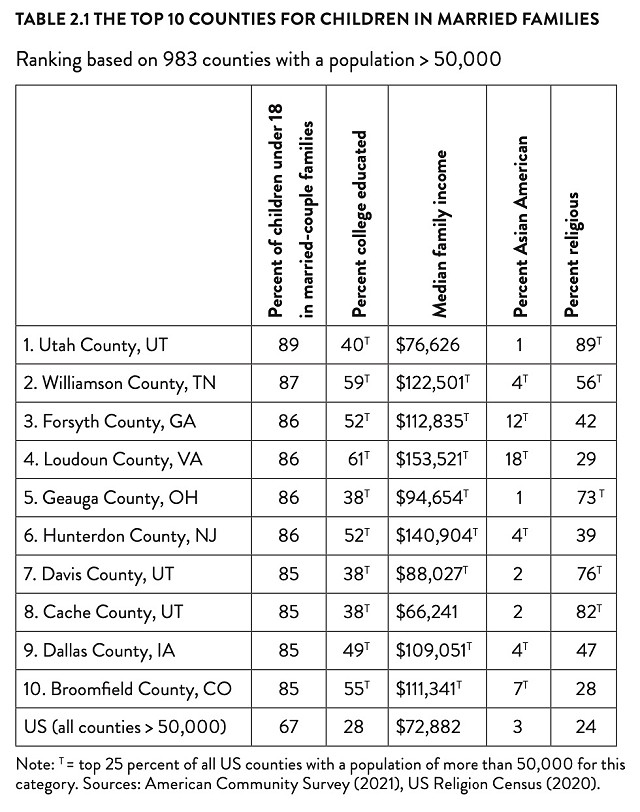Highlights
- What faith and Utah County can tell us about the secret to a happy marriage. Post This
- Faith is the strongest predictor of marital quality when compared to other factors like ideology, education, race and income. Post This
- The quality and stability of marriages across the land also matter for that universal quest: the pursuit of happiness. Post This
Everyone wants to know the surefire secret to success at love and marriage. That’s why the local Barnes & Noble aisle on relationships is packed with books full of tips on how to win at love. One of the better offerings in this department is psychologist John Gottman’s bestselling book, “The Relationship Cure: A 5-Step Guide to Strengthening Your Marriage, Family, and Friendships.”
The book is based in part on wisdom Gottman gleaned from observing hundreds of couples at his “Love Lab” at the University of Washington in Seattle to determine what goes into strong and stable relationships. Based on his research, he advises couples to do things like steering clear of what he calls the “Four Horsemen of the Apocalypse”: stonewalling, defensiveness, criticism and contempt. There’s a lot to learn from his research.
However, Gottman is focusing on what might be called the “microclimate” of an individual marriage — the discrete interactions that make for a good or bad relationship. As a sociologist, I am interested in studying the wider contexts, the “macroclimates,” in which strong and stable marriages thrive. Why is it that the picture-perfect Laurelhurst community near his Love Lab has lots of stable families and a Seattle neighborhood just several miles south of his lab is dominated by single parents? And what explains why marriage is strong in some communities and weak in others across the nation?
Part of the sociological answer to these questions is about money. Marriage tends to be stronger in neighborhoods where the cash flow is better, neighborhoods like Laurelhurst where there is less poverty and more affluence. Higher-income neighborhoods are dominated by two-parent families — about 80 percent of the families with children. Lower-income neighborhoods, by contrast, are places where almost 50 percent of the families are headed by single parents. That’s in part because financial stress and unemployment — especially on the part of men — are major drivers of relationship discord and divorce.

But money isn’t the whole story. Culture also matters. When we look at counties across the United States, one cultural factor shaping family life zooms into focus: faith.
Consider, for instance, Utah County, Utah, which has the highest proportion of married families of any midsize-to-large county (more than 50,000 people) in America. In recent years, the county has prospered in part because it has attracted a number of California companies — from Adobe to Intel — and midwifed a number of startups seeking out its highly motivated workforce and favorable tax burden. Still, those living there are not in the upper echelons of America when it comes to income: The median household income was around $77,000 in 2021, which positions it solidly in a middle-class bracket. What really makes this county stand out is the faith factor. The population is predominantly members of The Church of Jesus Christ of Latter-day Saints.
But Utah County is not an outlier. When we look at the midsize-to-large counties with the most children living in a married family, the most religious counties in the country are disproportionately likely to make the list. Utah County is No. 1 on this family indicator, and the second most religious county in America — measured by the share of adults who report a religious affiliation. But outside of Utah, places like Williamson County in Tennessee, which has lots of churchgoing evangelical Protestants, and Geauga County in Ohio, which is 20 percent Amish, also land on this list. Of these top 10 counties, half are among the most religious places in the nation (in the top 25 percent for religious affiliation in the nation). Clearly, then, religion is one factor at the county level when it comes to family stability.

If we look above and beyond neighborhoods and counties, nationally representative surveys identify four groups that stand out for being masters of marriage — those who are most likely to get married, steer clear of divorce court and forge reasonably happy unions.
1. The Faithful. I use the term loosely to refer to those Americans who attend worship services several times a month or more. Their ties to their local religious communities endow their marriages and family lives with deep spiritual significance.
Fellow adherents can provide practical, social, emotional and even financial support when called upon. They are most likely to believe, on principle, that the institution of marriage is good for the well-being of kids, communities and the country.
2. The Conservatives. This group embraces classic American middle-class, or what scholars call “bourgeois,” values — like education, hard work, financial success and personal responsibility — as well as “traditional” values like the importance of religion, marriage, sexual fidelity in marriage and the idea that men and women are inherently different. Today, for Conservatives who are and are not religious, their commitments to more traditional beliefs about family, sex and gender are also shaped by conservative media, public intellectuals and friends.
3. The Strivers. This group also embraces “bourgeois” values and tend to more likely take the long-term view and embrace delayed gratification. Strivers largely dominate the professions, the business world, the universities and the media. Even though many hold fashionably liberal views about family matters — including politically correct attitudes about family diversity and single motherhood — they do not put these views into practice in their own private lives.
4. Asian Americans, who also tends to embrace Striver-style values and “are the highest-income, best-educated, and fastest-growing racial group in the United States,” as Bruce Drake from Pew Research Center pointed out.
Asian Americans’ devotion to Eastern-style traditional family values is also a big part of their American success story. Their orientation to marriage is rooted in a combination of principle and prudence: Their traditions — be they Confucian, Hindu or Muslim — push them in a family-first direction. And they recognize that stable families give their kids a big head start in their pursuit of the American dream.
Statistics in the General Social Survey show that these groups are more inclined to marry and stay married. That kind of stability is important, but the quality of married life also matters. After all, a stable marriage is not as valuable for the children or for the adults if the parents are miserable. So, how do these four groups fare when it comes not just to the stability of their marriages but also to the quality of their unions?
Strivers are happier husbands and wives. College-educated husbands and wives are about 5 percentage points more likely to report that they are “very happy” in their marriages, compared to married adults without a college degree. In fact, higher education is the second most powerful predictor of marital quality when we account for key sociodemographic factors in our analyses.
For the Faithful, meanwhile, the data is especially clear. Husbands and wives who attend religious services frequently are about 6 percentage points more likely to report they are “very happy” in their marriages, compared to those who attend sporadically or not at all. In fact, the GSS found that faith is the strongest predictor of marital quality when compared to other factors like ideology, education, race and income.
Conservatives are also happier in their marriages. They enjoy a 6-percentage-point advantage over moderates and a 5-percentage-point advantage over liberals. More fine-grained analyses indicate that the happiest husbands and wives hail from the “very conservative” camp.
The Asian advantage is more modest when it comes to marital quality, at least as Americans. They are only a few percentage points more likely to be in the happiest wives and husbands club, compared to married African Americans and Hispanics, and they are not happier than married white people. In fact, it is precisely because Asian Americans are more likely to pursue family stability that they are more willing than other Americans to put up with a difficult marriage.
The quality and stability of marriages across the land also matter for that universal quest: the pursuit of happiness. Consider the growing happiness divide in American life. Educated and affluent people have seen their happiness levels dip a bit in recent years, but the “happiness of lower-SES (socioeconomic status) people” has decreased dramatically, according to psychologist Jean Twenge. This means there’s a growing happiness gap between more privileged and less privileged Americans. Guess what is one of the biggest factors explaining our country’s class divide in happiness?
Marriage.
It turns out that the marriage rate is in free fall among our country’s poor and working class. This translates into “less happiness among those with lower SES,” Twenge observed. By contrast, marriage is in much better shape among affluent Americans, which helps explain why they are doing much better in the happiness department.
Research like this tells us that what happens in our hearts and homes doesn’t just matter for our own well-being, it matters for the welfare of our children and country. So, on Valentine’s Day, if you’re married, for your own sake — and, indeed, the sake of our civilization — I urge you to find new ways to honor your commitment to love and cherish your spouse and any children you may have all the days of your life.
Adapted from the book, Get Married: Why Americans Must Defy the Elites, Forge Strong Families, and Save Civilization, by Brad Wilcox. Copyright © 2024 by W. Bradford Wilcox. Reprinted by permission of Broadside Books, an imprint of HarperCollins Publishers.
Editor's Note: This article appeared first at Deseret News and has been reprinted here in with permission.










